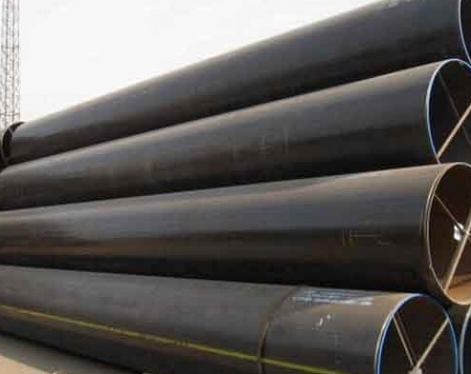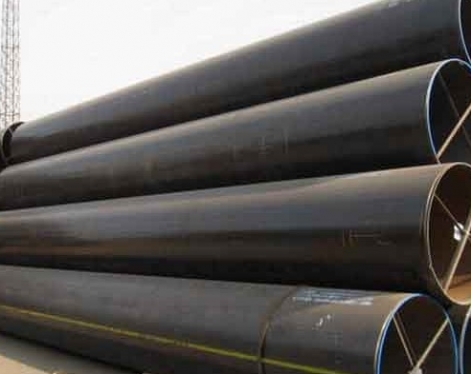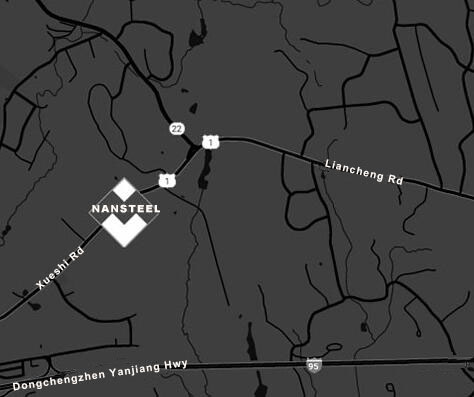What are steel pipe piles?
Steel pipe piles are a type of building material made of steel pipes, mortises, and tenons. In actual applications, these steel pipe piles overlap each other to form an arc or circular structure, thereby playing the role of enclosing water, soil, and sand. They are commonly seen in offshore dock construction as an important basic support structure.
Steel pipe piles come in a variety of sizes and specifications. Their outer diameters are generally 50-120cm, and their wall thicknesses are mostly 1-1.8cm. However, the specific sizes and specifications will be adjusted according to the needs of the actual project. For example, some large-scale dock construction may use steel pipe piles with larger diameters and thicker walls to meet higher load-bearing requirements.
Outstanding features of steel pipe piles
1. Strong carrying capacity
Steel pipe piles are usually made of steel, which has the characteristics of high strength and good toughness, which enables steel pipe piles to withstand larger loads. In practical applications, steel pipe piles can effectively penetrate the soft soil layer and enter the hard bearing layer by virtue of their own strength advantages, giving full play to their high bearing capacity.
2. Excellent horizontal resistance
Steel pipe piles have a large section modulus, which means that they have a strong ability to resist bending moments and can withstand large horizontal forces. This characteristic of steel pipe piles is particularly important in building structures that are subject to large lateral forces, such as docks, abutments and piers.
3. High flexibility in design and construction
In terms of design, the size of the steel pipe piles can be flexibly changed according to the actual needs of the project. Whether it is adjusting the diameter of the pile or changing the wall thickness of the pile, it can be easily achieved, which provides designers with more options and enables them to design the most suitable foundation plan according to different geological conditions and engineering requirements.
4. Environmental advantages
The bottom of the steel pipe pile is usually designed to be open, so that the soil can naturally flow into the pile pipe during the pile sinking process. Compared with solid piles, this method greatly reduces the extrusion of the surrounding soil, thereby reducing the degree of disturbance to the surrounding foundation, effectively avoiding the occurrence of soil uplift, and has less impact on the surrounding environment, which has obvious environmental advantages.

Detailed explanation of the production process of steel pipe piles
1. Raw material inspection: The production of steel pipe piles cannot be separated from high-quality raw materials. Strip steel coils, welding wires, and welding fluxes must undergo strict physical and chemical tests before being put into production. Only when all indicators of raw materials meet the requirements can the foundation be laid for the subsequent production of high-quality steel pipe piles.
2. Steel plate forming: Use a plate rolling machine to roll the steel plate into a tube shape, and accurately control the tube diameter and roundness. Use welding technology to weld the edges of the steel plate together to form a steel tube prototype. During the welding process, the current and voltage are strictly controlled to ensure the quality of the weld.
3. Pipe end processing: Use lathes, milling machines and other equipment to process both ends of the steel pipe to ensure that the pipe ends are flat and accurate in size to meet design and construction requirements. Some projects also require special processing of the pipe ends, such as groove processing, to facilitate subsequent connection.
4. Quality inspection: Ultrasonic flaw detection, X-ray flaw detection and other technologies are used to inspect the welds of steel pipes to ensure that there are no defects such as cracks and pores. Through water pressure tests, the pressure resistance and sealing of steel pipes are tested to ensure that there are no leakage, deformation and other problems during use.
5. Surface treatment: To enhance the corrosion resistance of steel pipe piles, surface treatment is required. Common methods include hot-dip galvanizing and anti-corrosion coating. Hot-dip galvanizing can form a dense zinc layer on the surface of the steel pipe, effectively isolating air and moisture; anti-corrosion coating can provide targeted protection according to different environmental requirements.
6. Finished product acceptance and stacking: After passing the quality inspection, the steel pipe piles are numbered and recorded for easy construction and use. The stacking site is reasonably planned to avoid deformation and damage of the steel pipe piles due to improper stacking, thus ensuring the quality of the finished product.
Steel pipe piles: the "pillar" of multi-field projects
1. Construction projects: In the construction of high-rise buildings and large commercial complexes, due to the shortage of urban land, there is a great demand to extend the buildings underground.
2. Bridge engineering: Whether it is a cross-sea bridge or a city viaduct, steel pipe piles are indispensable. In aquatic environments, it can penetrate complex geological layers, penetrate deep into the stable bearing layer, provide solid support for bridge piers, and resist water erosion and wind and wave impacts.
3. Port and wharf engineering: Port and wharf have long been affected by seawater erosion, ship collisions and tides. Steel pipe piles are highly corrosion resistant and can be treated with special anti-corrosion treatment to extend their service life. They can also withstand the huge loads generated by ships docking and loading and unloading cargo.
4. Marine engineering: In the construction of offshore wind power and oil platforms, facing the harsh marine environment, steel pipe piles take root in the seabed with their high strength and stability, providing reliable support for the towering wind power towers and huge oil platforms, ensuring the safe operation of offshore energy facilities and facilitating the development of marine energy.
5. Municipal engineering: When constructing municipal projects such as urban subways and underground integrated pipe galleries, steel pipe piles are often used for foundation pit support to ensure construction safety and reduce the impact on the surrounding environment.
Read more:Advantages and Disadvantages of Steel Pipe Piles
Steel pipe piles are a type of building material made of steel pipes, mortises, and tenons. In actual applications, these steel pipe piles overlap each other to form an arc or circular structure, thereby playing the role of enclosing water, soil, and sand. They are commonly seen in offshore dock construction as an important basic support structure.
Steel pipe piles come in a variety of sizes and specifications. Their outer diameters are generally 50-120cm, and their wall thicknesses are mostly 1-1.8cm. However, the specific sizes and specifications will be adjusted according to the needs of the actual project. For example, some large-scale dock construction may use steel pipe piles with larger diameters and thicker walls to meet higher load-bearing requirements.
Outstanding features of steel pipe piles
1. Strong carrying capacity
Steel pipe piles are usually made of steel, which has the characteristics of high strength and good toughness, which enables steel pipe piles to withstand larger loads. In practical applications, steel pipe piles can effectively penetrate the soft soil layer and enter the hard bearing layer by virtue of their own strength advantages, giving full play to their high bearing capacity.
2. Excellent horizontal resistance
Steel pipe piles have a large section modulus, which means that they have a strong ability to resist bending moments and can withstand large horizontal forces. This characteristic of steel pipe piles is particularly important in building structures that are subject to large lateral forces, such as docks, abutments and piers.
3. High flexibility in design and construction
In terms of design, the size of the steel pipe piles can be flexibly changed according to the actual needs of the project. Whether it is adjusting the diameter of the pile or changing the wall thickness of the pile, it can be easily achieved, which provides designers with more options and enables them to design the most suitable foundation plan according to different geological conditions and engineering requirements.
4. Environmental advantages
The bottom of the steel pipe pile is usually designed to be open, so that the soil can naturally flow into the pile pipe during the pile sinking process. Compared with solid piles, this method greatly reduces the extrusion of the surrounding soil, thereby reducing the degree of disturbance to the surrounding foundation, effectively avoiding the occurrence of soil uplift, and has less impact on the surrounding environment, which has obvious environmental advantages.

Detailed explanation of the production process of steel pipe piles
1. Raw material inspection: The production of steel pipe piles cannot be separated from high-quality raw materials. Strip steel coils, welding wires, and welding fluxes must undergo strict physical and chemical tests before being put into production. Only when all indicators of raw materials meet the requirements can the foundation be laid for the subsequent production of high-quality steel pipe piles.
2. Steel plate forming: Use a plate rolling machine to roll the steel plate into a tube shape, and accurately control the tube diameter and roundness. Use welding technology to weld the edges of the steel plate together to form a steel tube prototype. During the welding process, the current and voltage are strictly controlled to ensure the quality of the weld.
3. Pipe end processing: Use lathes, milling machines and other equipment to process both ends of the steel pipe to ensure that the pipe ends are flat and accurate in size to meet design and construction requirements. Some projects also require special processing of the pipe ends, such as groove processing, to facilitate subsequent connection.
4. Quality inspection: Ultrasonic flaw detection, X-ray flaw detection and other technologies are used to inspect the welds of steel pipes to ensure that there are no defects such as cracks and pores. Through water pressure tests, the pressure resistance and sealing of steel pipes are tested to ensure that there are no leakage, deformation and other problems during use.
5. Surface treatment: To enhance the corrosion resistance of steel pipe piles, surface treatment is required. Common methods include hot-dip galvanizing and anti-corrosion coating. Hot-dip galvanizing can form a dense zinc layer on the surface of the steel pipe, effectively isolating air and moisture; anti-corrosion coating can provide targeted protection according to different environmental requirements.
6. Finished product acceptance and stacking: After passing the quality inspection, the steel pipe piles are numbered and recorded for easy construction and use. The stacking site is reasonably planned to avoid deformation and damage of the steel pipe piles due to improper stacking, thus ensuring the quality of the finished product.
Steel pipe piles: the "pillar" of multi-field projects
1. Construction projects: In the construction of high-rise buildings and large commercial complexes, due to the shortage of urban land, there is a great demand to extend the buildings underground.
2. Bridge engineering: Whether it is a cross-sea bridge or a city viaduct, steel pipe piles are indispensable. In aquatic environments, it can penetrate complex geological layers, penetrate deep into the stable bearing layer, provide solid support for bridge piers, and resist water erosion and wind and wave impacts.
3. Port and wharf engineering: Port and wharf have long been affected by seawater erosion, ship collisions and tides. Steel pipe piles are highly corrosion resistant and can be treated with special anti-corrosion treatment to extend their service life. They can also withstand the huge loads generated by ships docking and loading and unloading cargo.
4. Marine engineering: In the construction of offshore wind power and oil platforms, facing the harsh marine environment, steel pipe piles take root in the seabed with their high strength and stability, providing reliable support for the towering wind power towers and huge oil platforms, ensuring the safe operation of offshore energy facilities and facilitating the development of marine energy.
5. Municipal engineering: When constructing municipal projects such as urban subways and underground integrated pipe galleries, steel pipe piles are often used for foundation pit support to ensure construction safety and reduce the impact on the surrounding environment.
Read more:Advantages and Disadvantages of Steel Pipe Piles









